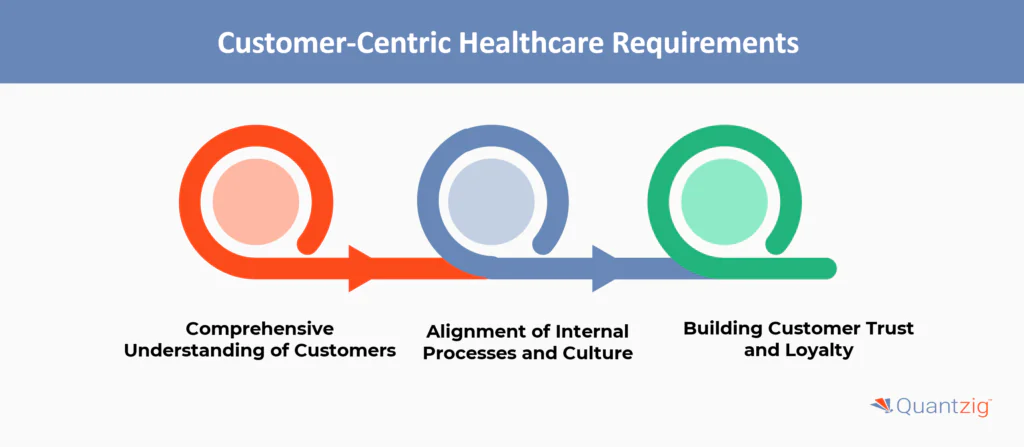Author: Associate Vice President, Analytics and Data Strategy, Quantzig.
Table of Contents
Introduction to Customer Centric Healthcare
The healthcare industry is undergoing a profound transformation, with payers at the forefront of this change. Driven by the rise of consumerism and the need to deliver better value, healthcare payers are shifting their focus from traditional patient engagement to a more customer-centric approach. This strategic shift is enabling payers to better understand and cater to the evolving needs and preferences of their members, ultimately leading to improved health outcomes, enhanced customer satisfaction, and increased operational efficiency. By leveraging data-driven insights, digital technologies, and collaborative partnerships, payers are redefining the healthcare experience and positioning themselves as trusted advisors in the pursuit of personalized, accessible, and high-quality care.
Book a demo to experience the meaningful insights we derive from data through our analytical tools and platform capabilities. Schedule a demo today!
Request a Free DemoWhat Does It Mean to Prioritize the Customer?
Here are 5 key ways healthcare payers can focus on customer centricity:
- Personalized Products and Services: Payers should leverage data and analytics to develop personalized insurance plans, wellness programs, and care management services tailored to individual needs and preferences. This could include customized benefit packages, targeted outreach, and proactive engagement.
- Seamless Digital Experiences: They can invest in user-friendly digital platforms and mobile apps that allow customers to easily access information, manage their coverage, and communicate with their care providers. Streamlining administrative tasks can significantly improve the customer experience.
- Coordinated Care Delivery: Payers should work closely with providers to integrate care across the healthcare ecosystem. This includes facilitating data sharing, aligning incentives, and embedding care coordinators within practices to ensure a cohesive, patient-centric experience.
- Preventive Health Focus: They can incentivize and empower customers to take a more active role in their health by promoting preventive care, wellness programs, and chronic disease management. This can lead to better outcomes and lower costs in the long run.
- Transparency and Trust: Payers should enhance transparency around costs, coverage, and quality metrics to build trust with customers. Clear communication and easy access to relevant information can help customers make informed decisions about their healthcare.
By adopting a customer-centric approach, healthcare payers can improve satisfaction, drive better health outcomes, and position themselves as valuable partners in the evolving healthcare landscape.
Customer-Centric Requirements

1. Comprehensive Understanding of Customers:
- Requires in-depth research, data analysis, and gathering of customer insights.
- Focuses on identifying customers’ wants, pain points, and preferences.
2. Alignment of Internal Processes and Culture:
- Involves restructuring internal processes to better serve customer needs.
- Cultivates a culture and employee behaviors dedicated to enhancing the customer experience.
3. Building Customer Trust and Loyalty:
- Aims to foster trust, loyalty, and advocacy among customers.
- Drives business growth and success in a highly competitive marketplace by prioritizing customer satisfaction.
This professional approach ensures that the organization remains focused on delivering superior customer experiences, leading to sustainable competitive advantages.
Healthcare Payers and Customer Centricity
A customer-centric approach can benefit healthcare providers and payers in several ways. By adopting this approach, organizations can involve individual consumers in their own care process. To improve customer experience, healthcare payers must assess the existing customer journey by leveraging big data analytics to improve the buying experience for existing as well as new customers.
This approach coupled with analytics offers actionable insights to healthcare payers, helping them resolve customer issues and complaints. It also assists in empowering patients to manage their own health and adapt to dynamic consumer needs. Analytics plays a crucial role in addressing important issues for healthcare providers and payers, driving brand and customer engagement, and aiding in navigating healthcare decisions.
A Brief Overview of Customer-centric Service Model
1. Definition of a Customer-Centric Service Model:
A customer-centric service model in healthcare refers to an approach that prioritizes the needs and preferences of patients or customers. It aims to provide the highest-quality care options while considering factors such as mental illness, hypertension, and overall health outcomes. This model recognizes the importance of addressing these conditions and their impact on individuals’ well-being.
2. Prevention of Self-Medicating Practices:
One key aspect of this model is the focus on preventing self-medicating practices. By providing necessary prescriptions and educating patients about the risks associated with self-medication, healthcare organizations can ensure that individuals receive appropriate treatment and avoid potential harm.
3. Transparency in Healthcare Costs:
Moreover, this model emphasizes the importance of transparency in healthcare costs. It aims to provide clear information about site-of-care costs, enabling patients to make informed decisions about their healthcare options. This transparency helps individuals understand the financial implications of their choices and promotes cost-effective decision-making.
4. Care Navigation:
Care navigation is another crucial component of a customer-centric service model. By offering guidance and support, healthcare systems can help patients navigate the complex healthcare landscape. This includes connecting individuals with the right clinicians, testing clinics, and digital health resources that align with their specific needs.
5. Role of Healthcare Organizations and CEOs:
Ultimately, this model places the customers at the center of healthcare delivery. It prioritizes their satisfaction, well-being, and access to the highest-quality care options while considering their mental health, chronic conditions like hypertension, and overall health outcomes. Healthcare organizations and CEOs play a vital role in implementing and promoting this model to ensure exceptional customer service in the healthcare industry.
Also Read: Track Business Progress with Marketing Analytics Dashboard
Experience the advantages firsthand by testing a customized complimentary pilot designed to address your specific requirements. Pilot studies are non-committal in nature.
Request a Free PilotLeverage Analytics to Drive Customer-Centricity
Healthcare payers can leverage data analytics to gain a deeper understanding of their customers and make strategic decisions driven by insights. Through analytics, payers can enhance customer experience, manage operations in a better way, resolve client issues, and identify their preferences and behavior through proper segmentation. Healthcare providers and payers can improve customers’ experience by utilizing the insights gained through big data analytics, in the following ways:
- Simplifying the customer enrollment process
- Ensuring effective management of patient’s healthcare and medical needs
- Increasing awareness among consumers about various available products and coverages
- Offering quick resolutions to various billing, claims, and coverage queries through multiple accessible channels
Conclusion
The healthcare industry is evolving towards a consumer-centric model, emphasizing patient engagement, personalized care, and superior consumer experience. Healthcare payers and healthcare providers are focusing on customer needs and customer expectations to improve patient outcomes and enhance patient-provider relationships. By leveraging patient satisfaction scores and patient reviews, these organizations aim to foster customer loyalty and build strong customer relationships. The shift towards service excellence and patient empowerment is transforming the healthcare system, aligning it more closely with consumer behavior and consumer-centric companies, ultimately ensuring a better healthcare journey for all.




